King Alfred’s England:
Anglo-Saxon Kingdoms and Royal Predecessors
King Alfred is popularly known as the first king of all England. The truthfulness of this epithet depends on many factors that historians have discussed for centuries. This page examines the various kingdoms of Anglo-Saxon England and their most notable rulers prior to Alfred’s reign so that Alfred’s accomplishments can be viewed in the context in which they were achieved.
Rule and Withdrawal of the Roman Empire in Britain
There are several known kingdoms among the Britons that were either subjugated or subsidized by Roman authority. Among these were the Dumnouii, the Durotriges, the Belage, the Atrebates, the Coritani, Cantii, Trinovantes, Catuvellauni, the Regnii, and the Iceni. Perhaps the most famous ruler of these various kingdoms is Queen Boudicca of the Iceni, wife of King Prasutagus, famous for her bloody revolt against the Romans unusually harsh treatment of her tribe. Upon her husband’s death the Roman’s seized the Iceni kingdom. When Boudicca resisted she was publicly flogged and her daughters were raped. In response the Iceni and several surrounding tribes united under Boudicca (Tacitus note his surprise that the tribes would unite under woman’s leadership) and razed Colchester, Verulamium and Londinium to the ground before being decimated by Roman Legionaries. A happier ruler, Cogidubnus, of the Regnii, joined forces with Rome and built a Roman style villa at Fishbourne, near Chichester.
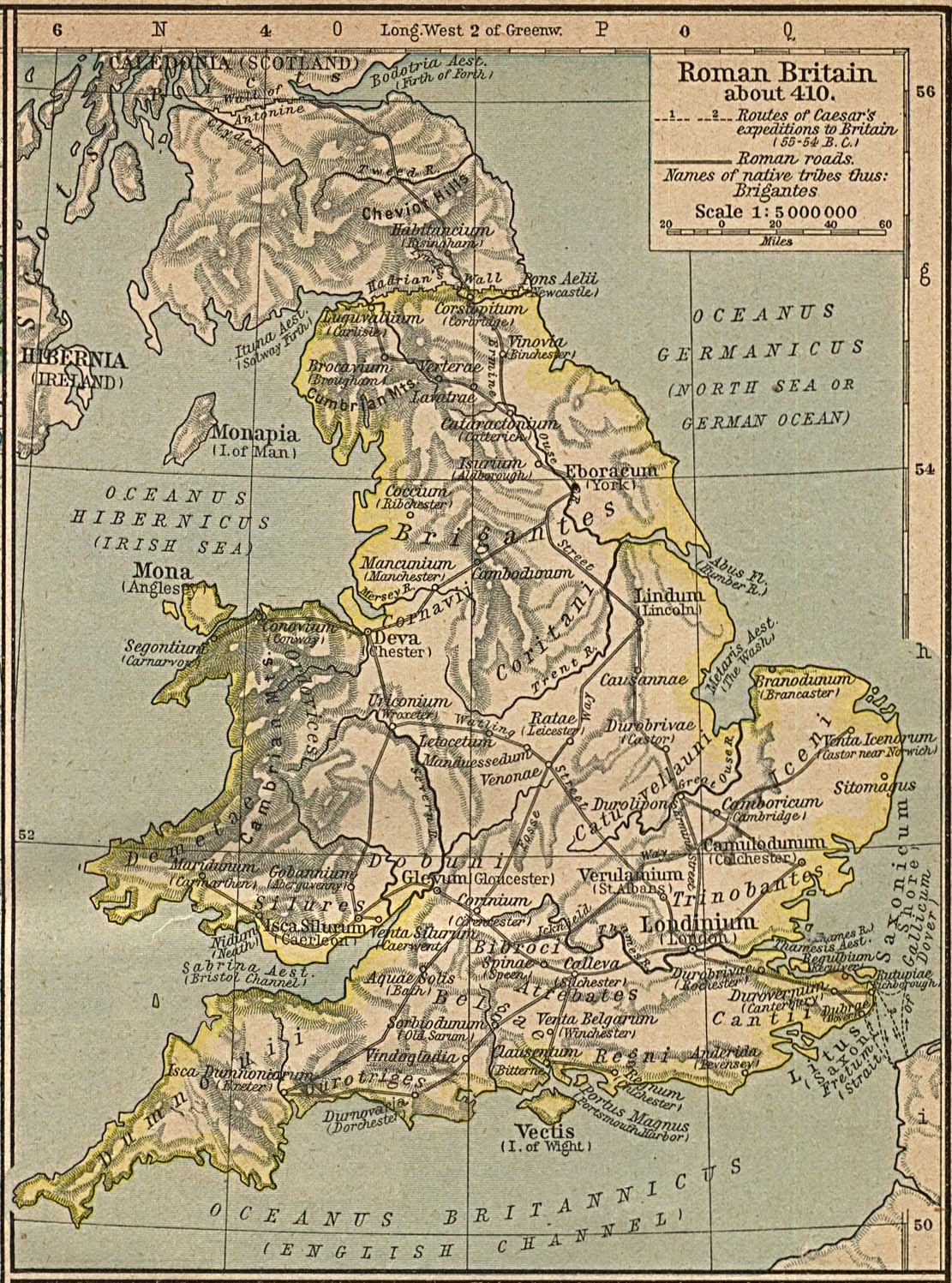
Britain about 410ad, about the time of the withdrawal of Roman forces.
Statue commemorating Boudicca’s rebellion on Westminster Bridge in London.
The Anglo-Saxon Invasion
The Briton king credited with inviting Germanic tribes into Britain as mercenary solders named Vortigern. He ostensibly neglected to pay them, inciting their ire and provoking them to plunder his people and steal his lands, opening the doors for the Angles and Saxons, among other peoples, to settle in Britain.
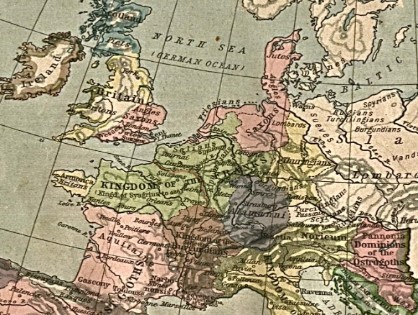
Map showing the origins and settlements of Germanic tribes destined to settle in Britain.
Aethelbert of Kent-Reportedly the first Christian King in Anglo-Saxon Britain. His wife Bertha was already Christian and he allowed her to worship in a small church in Canterbury with Roman origins which, with later additions, still stands today. According to legend, Aethelbert had his first meetings with Augustine beyond the city walls, believing that the open air would diffuse Augustine’s powers.
St. Martin’s in Canterbury. Supposedly the church used by Queen Bertha until her husband King Aethelbert converted to Christianity. The view of the church is complimented by a Victorian Gothic gravestone.
Another view of St. Martin’s in Canterbury. The lampost is original.
The Anglo-Saxon Heptarchy
Although the idea that Anglo-Saxon England was divided into seven well-defined kingdoms is misleading, historians have found it helpful to examine the power-shifts among the various kings in light of the seven most prominent of the ever-fluctuating realms, Northumbria, Mercia, East Anglia, Wessex, Sussex, Essex, and Kent, pictured below. To illustrate the confusion among the seperate kingdoms, the heptarchial map depicts eight kingdoms, including the minor kingdom Lindsey.
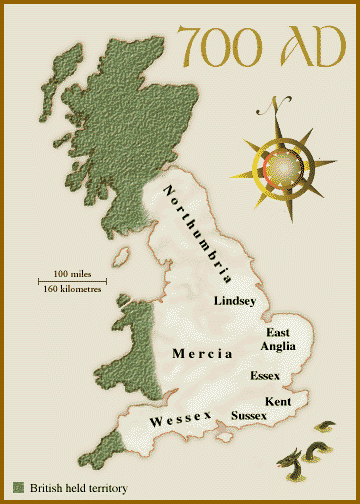
Redwald of East Anglia-The king to whom the burial at Sutton Hoo was probably dedicated. He was accused by Bede of having blended Pagan and Christian practices. Artifacts from the burial as well as others dated to his reign display mixed symbols from both beliefs. Bede includes Redwald in a list of the dominant kings of the Anglo-Saxon Kingdoms. Though it is clear that there were still independent kingdoms ruled by various lords, this list suggests that some kings at the least had considerable influence among their peers.
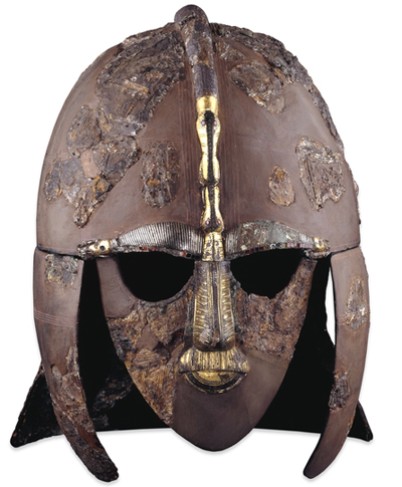
The famous Sutton Hoo helmet buried in East Anglia, perhaps with East Anglian King Redwald.
Athelfrith of Northumbria- Athelfrith was responsible for consolidating much of the power of the kingdom of Northumbria from 593 to 613. He fought a combined force of Scots and Irish in the North, the Welsh to the West, and invaded Deria to the South, killing the Derian king Athelric. His conquests earned him the nicknames Athelfrith the Artful and Athelfrith the Ferocious. He continued to consolidate and expand his power until he died in battle in at Doncaster after slaughtering a party of monks who were providing sanctuary to Edwin, brother of Athelric and Athelfrith’s chief rival.
Edwin of Northumbria-Edwin succeeded Athelfrith to the throne of Northumbria, continuing to expand Northumbrian power. He converted to Christianity and facilitated the conversion of his entire kingdom. He also established an archbishopric at York. His kingdom, the most powerful of its day, was divided and crippled when Edwin fell in battle against a combined army of Welsh and Mercians led by Penda. This loss gave rise to the powerful Mercian kingdom ruled by Penda’s successors, Wulfhere and Athelred, who’s power reached as far south as Sussex.
Offa of Mercia-Probably the most powerful of Alfred’s predecessors was Offa, who ruled from 757 to 796. Offa demanded recognition from all the kings of the surrounding kingdoms and was even recognized to some extent in parts of Wales and Scotland. Under his reign Mercia emerged as the most powerful of the English kingdoms. Its power waned, however, under the rule of his successors.
Wessex, the kingdom that would be ruled by Alfred as he expanded his power throughout all of England, first rose to prominence under the ruthless leader Caedwalla, who used his band of mercenaries to wipe out any minor kings who stood in the way of his rising power. He was succeeded by Ine, who became famous for his law codes and establishment of organized government and ruled there from 688-726.
Egbert of Wessex-Henceforth a relatively minor kingdom, Wessex rose to the position of the most powerful kingdom under the reign of Alfred’s grandfather, Egbert, who ruled Wessex from 802-838. He expanded the Wessex boarders on all sides and aided other kingdoms in their disputes, earning their allegiances and establishing his power as their overlord. He conquered Essex and Sussex and aided East Anglia in defeating Mercia, spreading his influence over all the English. It was during Egbert’s reign that the Viking invasions began to threaten the power of the Anglo-Saxon kings, setting the stage for Alfred to build upon the foundation set up by his predecessors.
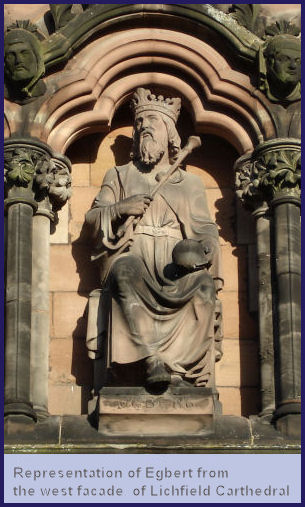
A statue of Egbert of Wessex from Lichfield Cathedral.